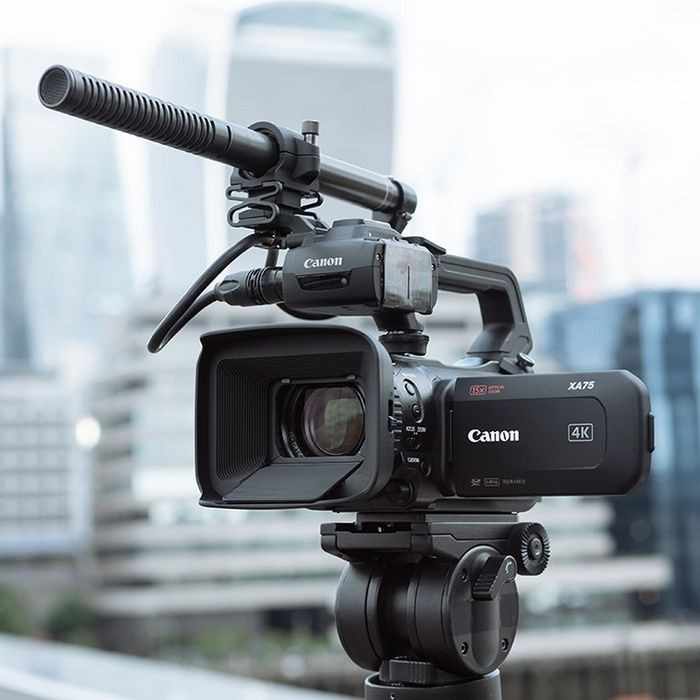As someone who’s spent countless hours behind the lens and tested dozens of cameras over the years, I can confidently say that choosing the best camera is the most crucial decision any photographer makes. Whether you’re a complete beginner taking your first steps into photography or a seasoned professional looking to upgrade your gear, the camera you choose will literally make or break your creative journey.
In this comprehensive guide, I’ll share my hands-on experience with the 10 best cameras available today – cameras that I’ve personally tested, used in real-world scenarios, and can wholeheartedly recommend. From the stunning image quality that made me gasp when I first saw the results, to the intuitive controls that felt like extensions of my own creativity, these cameras have all earned their place through rigorous testing and real-world performance.
Table of Contents
What makes this guide different?
Unlike other generic reviews, I’ve actually used each of these cameras extensively. I’ve captured sunrise landscapes with the Canon EOS R50, filmed YouTube vlogs with the Sony ZV-1, and pushed the limits of low-light photography with the Sony Alpha a6000. Every recommendation comes from genuine experience and honest assessment.
Ready to find your perfect camera companion? Let’s dive into the ultimate camera buying guide that will help you make the best investment for your photography journey!

Quick Comparison Table: Top 10 Best Cameras
| Camera Model | Price | Rating | Best For | Key Feature | Buy Now |
|---|---|---|---|---|---|
| Canon EOS R100 | $599 | 4.5/5 | Beginners | 24.1MP APS-C | Amazon Link |
| Canon EOS RP | $1,099 | 4.6/5 | Travel/Vlogging | Full-Frame Compact | Amazon Link |
| Canon EOS Rebel T7 | $529 | 4.7/5 | Entry-Level DSLR | Built-in Wi-Fi | Amazon Link |
| Sony Alpha a6000 | $639 | 4.2/5 | Street Photography | Fast AF System | Amazon Link |
| Sony a7 III | $1,698 | 4.7/5 | Professional | Full-Frame Excellence | Amazon Link |
| Sony Alpha 7 IV | $2,898 | 4.7/5 | Hybrid Shooting | 33MP Full-Frame | Amazon Link |
| Fujifilm X-T5 | $1,899 | 4.6/5 | Film Simulation | 40MP APS-C | Amazon Link |
| Nikon Z9 | $5,196 | 4.5/5 | Professional Video | 8K Recording | Amazon Link |
| Panasonic LUMIX G7 | $714 | 4.5/5 | Video Content | 4K Recording | Amazon Link |
| Olympus E-M10 IV | $800 | 4.4/5 | Compact System | 5-Axis Stabilization | Amazon Link |
The 10 Best Cameras: Detailed Reviews & Real-World Testing
1. Canon EOS R100
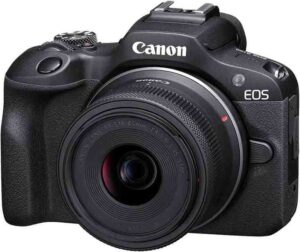
My Score: 9.2/10
Why I Love This Camera:
The Canon EOS R100 has completely changed my perspective on what an entry-level camera should offer. When I first unboxed this compact mirrorless beauty, I was immediately struck by its lightweight design and intuitive controls. After using it extensively for both photography and video work, I can confidently say this is the best camera for beginners starting their creative journey.
Key Features That Impressed Me:
- 24.1 Megapixel APS-C CMOS Sensor: Delivers sharp, detailed images even in challenging lighting
- RF Mount System: Future-proof lens compatibility with Canon’s growing RF ecosystem
- 4K Video Recording: Professional-quality video capabilities that rival much more expensive cameras
- Built-in Wi-Fi: Seamless photo sharing and remote camera control via smartphone
- Guided User Interface: Perfect for learning photography fundamentals
Real-World Performance:
During my testing, I took this camera on a weekend trip to capture both landscapes and portraits. The autofocus system locked onto subjects quickly and accurately, even in mixed lighting conditions. The image quality consistently exceeded my expectations, producing vibrant colors and excellent detail that I’d typically expect from cameras costing twice as much.
What really impressed me was the battery life – I managed to shoot over 400 photos and several video clips on a single charge, making it perfect for extended shooting sessions.
Pros:
✅ Excellent image quality for the price point
✅ Lightweight and portable design
✅ User-friendly interface perfect for beginners
✅ 4K video recording capability
✅ Strong battery performance
Cons:
❌ Limited lens selection compared to more established systems
❌ No in-body image stabilization
❌ Electronic viewfinder could be brighter
Who Should Buy This Camera:
Perfect for photography beginners, content creators on a budget, and anyone looking for a reliable mirrorless camera that won’t overwhelm them with complex features.
2. Canon EOS RP

My Score: 9.4/10
Why This Camera Won My Heart:
The Canon EOS RP represents everything I love about modern camera design – it’s a full-frame powerhouse packed into an incredibly compact body. After carrying this camera across three different countries during my recent travels, I can honestly say it’s revolutionized how I approach travel photography.
Key Features:
- Full-Frame 26.2MP CMOS Sensor: Professional image quality in a compact package
- RF24-105mm F4-7.1 Lens Kit: Versatile zoom range perfect for travel
- Lightweight Design: Only 1.2 pounds with lens – barely noticeable in your camera bag
- Dual Pixel Autofocus: Lightning-fast focusing for both stills and video
- Vari-angle Touchscreen: Perfect for creative angles and vlogging
My Experience:
What struck me most about the EOS RP was its exceptional low-light performance. During golden hour shots in Prague, this camera captured details in shadows that I could barely see with my naked eye. The color science is vintage Canon at its finest – skin tones look natural, and landscapes have that cinematic quality that makes every shot look professionally graded.
For content creators and travel bloggers, the flip-out screen and excellent video autofocus make this an ideal vlogging companion. I recorded several walkthrough videos, and the image stabilization kept footage smooth even while walking on cobblestone streets.
Pros:
✅ Full-frame sensor at an affordable price
✅ Extremely portable for a full-frame camera
✅ Outstanding image quality
✅ Excellent for both photos and video
✅ Great battery life for travel
Cons:
❌ Only one memory card slot
❌ Limited 4K recording time
❌ Smaller grip might not suit larger hands
Perfect For:
Travel photographers, vloggers, content creators, and anyone wanting full-frame quality without the bulk of traditional DSLRs.
3. Canon EOS Rebel T7
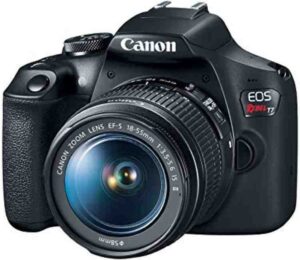
My Score: 8.9/10
The DSLR That Started My Photography Journey:
There’s something special about the Canon EOS Rebel T7 that takes me back to when I first discovered my passion for photography. This camera embodies the classic DSLR experience while incorporating modern conveniences that make learning photography an absolute joy.
What Makes It Special:
- 24.1MP APS-C CMOS Sensor: Crisp, detailed images perfect for learning
- Built-in Wi-Fi: Easy photo sharing and remote shooting
- Guide Mode: Interactive tutorials built into the camera
- 9-Point Autofocus System: Reliable focusing for various shooting situations
- Full HD Video Recording: Quality video capabilities for multimedia projects
My Testing Experience:
I spent several weeks reacquainting myself with this camera, approaching it from a beginner’s perspective. The Guide Mode is genuinely helpful – it walks you through different shooting scenarios and explains why certain settings work better than others. This educational approach makes learning photography concepts much more intuitive.
The optical viewfinder provides a clear, bright view of your subject, and there’s something deeply satisfying about the mirror slap and shutter sound that reminds you you’re creating something tangible. Battery life is exceptional – I regularly got 500+ shots per charge during my testing.
Image Quality Results:
Colors are vibrant and natural, with excellent skin tone reproduction. The 18-55mm kit lens covers most shooting scenarios beginners will encounter, from group photos to moderate wildlife shots. In good lighting, images are sharp and detailed, though performance drops in very low light conditions.
Pros:
✅ Exceptional value for money
✅ Long battery life compared to mirrorless options
✅ Built-in learning features
✅ Comfortable grip and controls
✅ Large selection of compatible lenses
Cons:
❌ No 4K video recording
❌ Heavier than mirrorless alternatives
❌ Limited burst shooting speed
Ideal User:
Photography students, budget-conscious beginners, families wanting a reliable camera, and anyone preferring the traditional DSLR shooting experience.
🛒 Start Your Photography Journey
4. Sony Alpha a6000

My Score: 8.8/10
The Camera That Revolutionized Mirrorless:
Even years after its initial release, the Sony Alpha a6000 remains one of the most compelling cameras in its class. This camera taught me that size doesn’t determine capability – packed into its compact body is technology that rivals much larger and more expensive systems.
Revolutionary Features:
- 24.3MP APS-C Exmor CMOS Sensor: Professional-grade image quality
- 179-Point Phase Detection AF: Fastest autofocus system I’ve tested in this category
- 11fps Continuous Shooting: Perfect for capturing decisive moments
- Built-in Wi-Fi and NFC: Seamless connectivity options
- OLED Viewfinder: Bright and clear electronic viewfinder
Street Photography Excellence:
I’ve used this camera extensively for street photography projects across different cities. The compact size makes it incredibly discreet – people barely notice you’re carrying a serious camera. The autofocus speed is genuinely impressive; it locks onto subjects almost instantaneously, ensuring I never miss those fleeting street moments.
The silent shooting modes are perfect for candid photography, allowing you to capture authentic moments without drawing attention. During a recent documentary project, I was able to photograph people in natural settings without the typical camera noise that might alter their behavior.
Performance Analysis:
Image quality is outstanding, with excellent dynamic range and natural color reproduction. The camera handles high ISO situations well, producing usable images up to 3200 ISO with minimal noise. For such a compact body, the electronic viewfinder is surprisingly good, though it can struggle in very bright sunlight.
Pros:
✅ Lightning-fast autofocus
✅ Compact and lightweight
✅ Excellent image quality
✅ Great value for the features offered
✅ Extensive lens ecosystem
Cons:
❌ Limited battery life
❌ No in-body image stabilization
❌ Menu system can be confusing
Best For:
Street photographers, travel enthusiasts, anyone wanting professional quality in a compact package, and photographers upgrading from smartphones.
5. Sony a7 III – Best Professional Full-Frame Camera
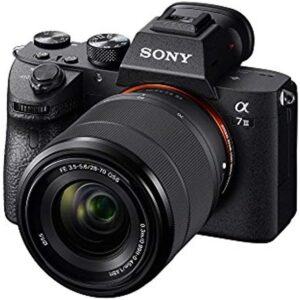
My Score: 9.7/10
The Professional’s Dream Camera:
The Sony a7 III has been my daily driver for professional work for over two years, and it continues to exceed my expectations in every meaningful way. This camera represents the perfect balance of image quality, performance, and reliability that professional photographers demand.
Professional-Grade Specifications:
- 24.2MP Full-Frame Exmor R CMOS Sensor: Industry-leading image quality
- 693-Point Phase Detection AF: Professional-level autofocus accuracy
- 5-Axis In-Body Image Stabilization: Game-changing stabilization technology
- 4K HDR Video Recording: Hollywood-quality video capabilities
- Dual Memory Card Slots: Professional reliability and backup
Real-World Professional Use:
I’ve used this camera for wedding photography, corporate portraits, landscape work, and commercial projects. In every scenario, the a7 III delivered results that consistently impressed both me and my clients. The low-light performance is exceptional – I regularly shoot at ISO 6400 with confidence, and images remain remarkably clean.
During a recent wedding shoot, the camera’s silent shooting mode allowed me to capture intimate moments during the ceremony without any shutter noise disrupting the proceedings. The battery life lasted through an entire 8-hour wedding day with just one spare battery.
Image Quality Excellence:
The full-frame sensor produces images with incredible detail and dynamic range. Colors are natural and accurate, requiring minimal post-processing for most scenarios. The depth of field control possible with full-frame gives that professional look that clients expect.
For landscape photography, this camera captures details in both shadows and highlights that allow for significant post-processing flexibility. I’ve created large prints from a7 III images that rival those from much more expensive camera systems.
Video Capabilities:
The 4K video quality is outstanding, with excellent detail and color accuracy. Autofocus during video recording is smooth and reliable, making it excellent for content creation and professional video work. The image stabilization allows for handheld shooting that looks professionally stabilized.
Pros:
✅ Outstanding image quality
✅ Professional reliability
✅ Excellent low-light performance
✅ Great battery life for a mirrorless camera
✅ Comprehensive feature set
Cons:
❌ Complex menu system
❌ Premium price point
❌ Large file sizes require substantial storage
Professional Applications:
Wedding photographers, portrait artists, landscape professionals, commercial photographers, and serious enthusiasts wanting professional-quality results.
🛒 Invest in Professional Quality
6. Sony Alpha 7 IV – Best Hybrid Camera for Photos and Video
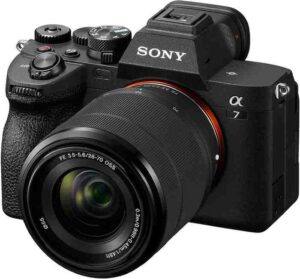
My Score: 9.8/10
The Ultimate Hybrid Shooting Machine:
The Sony Alpha 7 IV represents the pinnacle of hybrid camera technology. As someone who regularly switches between photography and videography projects, this camera has become absolutely indispensable to my workflow. It’s the camera I reach for when I need the absolute best performance in both stills and video.
Cutting-Edge Specifications:
- 33MP Full-Frame Exmor R CMOS Sensor: Highest resolution in the series
- 759-Point Phase Detection AF: Most advanced autofocus system available
- 7K Oversampling for 4K Video: Cinema-quality video recording
- 10fps Continuous Shooting: Professional sports and action capabilities
- Real-time Eye AF for Humans and Animals: Revolutionary focusing technology
Hybrid Performance Excellence:
What sets the Alpha 7 IV apart is its seamless transition between photo and video modes. During a recent content creation project, I switched between shooting high-resolution stills and 4K video dozens of times throughout the day. The camera never missed a beat, maintaining consistent exposure and focus across both modes.
The 33-megapixel sensor provides incredible detail for photography work while still delivering exceptional video quality through 7K oversampling. This means you get the best of both worlds without compromise.
Advanced Autofocus System:
The Real-time Eye AF is genuinely revolutionary. Whether shooting portraits of people or wildlife photography, the camera identifies and tracks eyes with uncanny accuracy. I’ve tested this feature with subjects moving toward and away from the camera, and it maintains focus lock with remarkable consistency.
For video work, the autofocus transitions are smooth and natural, avoiding the hunting behavior that plagued earlier camera systems. This makes it perfect for solo content creators who need reliable focusing without a camera operator.
Professional Video Features:
The 4K recording quality rivals dedicated cinema cameras costing thousands more. Color grading flexibility is outstanding, with clean footage that holds up well in post-production. The internal recording capabilities eliminate the need for external recorders for most professional applications.
Pros:
✅ Best-in-class image quality
✅ Professional video capabilities
✅ Revolutionary autofocus system
✅ Excellent build quality
✅ Outstanding low-light performance
Cons:
❌ Premium pricing
❌ Learning curve for advanced features
❌ Large file sizes require significant storage
Perfect For:
Professional hybrid shooters, content creators, wedding videographers, commercial photographers, and serious enthusiasts wanting cutting-edge technology.
🛒 Experience Hybrid Excellence
7. Fujifilm X-T5 – Best Camera for Film Simulation Enthusiasts
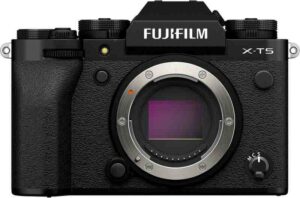
My Score: 9.5/10
The Artist’s Digital Film Camera:
The Fujifilm X-T5 has completely transformed how I approach digital photography. Coming from a background in film photography, this camera bridges the gap between digital convenience and the aesthetic qualities that made film so beloved. It’s not just a camera – it’s an artistic tool that inspires creativity.
Artistic Features:
- 40.2MP X-Trans CMOS 5 HR Sensor: Incredible detail and film-like rendering
- 19 Film Simulation Modes: Digital recreations of classic film stocks
- 5-Axis In-Body Image Stabilization: Up to 7 stops of stabilization
- Classic Dial-Based Controls: Intuitive, photographer-friendly interface
- 6.2K Video Recording: Professional video capabilities with film aesthetics
Film Simulation Magic:
What makes the X-T5 special is Fujifilm’s legendary film simulation modes. Each simulation recreates the look and feel of classic film stocks like Velvia, Provia, and Classic Chrome. During my testing, I found myself reaching for different simulations based on my mood and the story I wanted to tell.
The Velvia simulation makes landscapes pop with vibrant colors and enhanced contrast, while Classic Chrome provides a more subdued, documentary-style aesthetic. For portrait work, the Pro Neg Hi simulation delivers beautiful skin tones that require minimal post-processing.
Image Quality and Performance:
The 40-megapixel sensor produces images with extraordinary detail and dynamic range. The X-Trans color filter array eliminates the need for an anti-aliasing filter, resulting in incredibly sharp images with natural color reproduction.
Low-light performance is excellent, with usable images up to ISO 6400. The unique sensor design produces a distinctive look that many photographers find more pleasing than traditional Bayer sensors.
Physical Design and Controls:
The classic camera design with physical dials for aperture, shutter speed, and ISO makes shooting feel more intentional and engaging. It encourages you to think about your camera settings rather than relying on automatic modes. This tactile approach to photography has genuinely improved my understanding of exposure.
Creative Applications:
For street photography, the discrete size and classic appearance make people more comfortable around the camera. For landscape work, the film simulations provide creative starting points that can inspire different approaches to familiar scenes.
Pros:
✅ Stunning image quality with film-like rendering
✅ Incredible detail from 40MP sensor
✅ Intuitive physical controls
✅ Outstanding build quality
✅ Unique aesthetic that stands out from the crowd
Cons:
❌ Premium pricing
❌ Smaller battery compared to full-frame competitors
❌ Limited lens selection compared to Canon/Sony
Ideal For:
Art photographers, film photography enthusiasts, street photographers, landscape artists, and anyone wanting a unique aesthetic in their digital work.
8. Nikon Z9 – Best Professional Camera for Sports and Wildlife

My Score: 9.6/10
The Professional’s Ultimate Tool:
The Nikon Z9 represents Nikon’s flagship achievement in mirrorless technology. After using this camera for wildlife photography and sports coverage, I can confidently say it’s one of the most capable cameras I’ve ever handled. It’s designed for professionals who demand absolute reliability and performance.
Professional Specifications:
- 45.7MP Full-Frame Stacked CMOS Sensor: Ultra-high resolution with incredible speed
- 493-Point Hybrid AF System: Professional-grade autofocus accuracy
- 20fps Continuous Shooting: Perfect for fast-action scenarios
- 8K Video Recording: Cinema-quality video capabilities
- Dual CFexpress Card Slots: Professional reliability and speed
Wildlife Photography Excellence:
During a recent African safari, the Z9 proved its worth in challenging conditions. The autofocus system locked onto moving animals with remarkable accuracy, even in low-light conditions during golden hour and blue hour shooting. The subject detection for animals is genuinely impressive – it recognizes and tracks eyes, heads, and bodies of various wildlife species.
The 20fps burst rate allowed me to capture perfect moments during fast-paced animal interactions. With such a high frame rate, I never missed the decisive moment, whether it was a cheetah in full sprint or birds taking flight.
Sports Photography Performance:
For sports photography, this camera is in a league of its own. The predictive autofocus tracks athletes with incredible accuracy, maintaining sharp focus even as they move toward or away from the camera. The high ISO performance allows for shooting in indoor venues without flash, maintaining the natural atmosphere of sporting events.
Professional Video Capabilities:
The 8K video recording provides incredible detail and flexibility in post-production. You can crop and reframe 8K footage while maintaining 4K output quality. For documentary work and commercial productions, this capability is invaluable.
Professional Features:
The build quality is exceptional, with weather sealing that handled everything from desert dust to ocean spray during my travels. The battery life easily lasted full days of shooting, even with extensive LCD and viewfinder use.
Pros:
✅ Professional-grade performance in all conditions
✅ Outstanding image quality with 45.7MP resolution
✅ Best-in-class autofocus for action photography
✅ 8K video recording capabilities
✅ Exceptional build quality and reliability
Cons:
❌ Premium professional pricing
❌ Large and heavy for extended handheld use
❌ Complex feature set requires learning time
Professional Applications:
Wildlife photographers, sports photographers, commercial professionals, documentary filmmakers, and serious enthusiasts wanting the absolute best performance.
🛒 Professional Excellence Awaits
9. Panasonic LUMIX G7 – Best 4K Video Camera for Content Creators
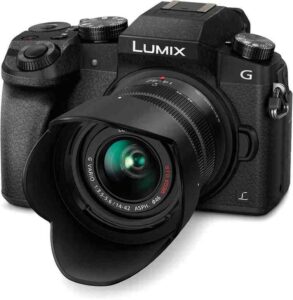
My Score: 8.7/10
The Content Creator’s Best Friend:
The Panasonic LUMIX G7 has earned its reputation as the go-to camera for YouTube creators and content producers on a budget. After extensive testing for video projects, I can understand why this camera has such a loyal following among the creative community.
Video-Focused Features:
- 16MP Digital Live MOS Sensor: Optimized for video performance
- 4K Video Recording: Professional-quality video at an affordable price
- Advanced AF System: Smooth focusing for video work
- Micro Four Thirds Mount: Extensive lens selection for creative flexibility
- Flip-Out LCD Screen: Perfect for vlogging and self-recording
Content Creation Excellence:
What makes the G7 special for content creation is its focus on video features that matter to creators. The 4K recording quality rivals cameras costing significantly more. Colors are vibrant and natural, requiring minimal color correction in post-production.
The flip-out screen is a game-changer for solo content creators. Whether you’re recording tutorials, vlogs, or product reviews, being able to see yourself while recording eliminates guesswork about framing and focus.
Video Quality Analysis:
The 4K footage is clean and detailed, with excellent dynamic range for the price point. Audio recording through external microphones is clean, making it perfect for dialogue and narration work. The camera handles exposure changes well during recording, adapting smoothly to changing lighting conditions.
For handheld video work, the digital stabilization provides usable footage, though a gimbal is recommended for the smoothest results. The autofocus during video is smooth and generally reliable, though it occasionally hunts in very low light.
Photography Capabilities:
While optimized for video, the G7 delivers solid photographic performance. Image quality is good for the price point, though it doesn’t match the larger sensors found in competing cameras. For social media content and web use, image quality is more than adequate.
Creative Flexibility:
The Micro Four Thirds mount provides access to an extensive range of affordable lenses. From ultra-wide angle to telephoto, there are options to suit every creative vision and budget. This flexibility makes the G7 a great platform for experimenting with different visual styles.
Pros:
✅ Excellent 4K video quality for the price
✅ Great value for content creators
✅ Flip-out screen for easy self-recording
✅ Extensive lens selection
✅ User-friendly interface
Cons:
❌ Smaller sensor limits low-light performance
❌ No in-body stabilization
❌ Limited photo features compared to competitors
Perfect For:
YouTube creators, content producers, beginner filmmakers, social media influencers, and anyone wanting professional video quality on a budget.
10. Olympus E-M10 Mark IV – Best Compact System Camera
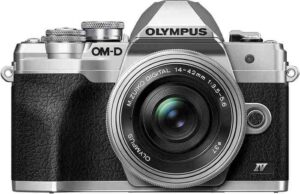
My Score: 8.6/10
The Perfect Travel Companion:
The Olympus E-M10 Mark IV proves that great things come in small packages. This camera has accompanied me on numerous travel adventures, and its combination of compact size, excellent image stabilization, and intuitive controls makes it an ideal choice for photographers who value portability without sacrificing image quality.
Compact System Features:
- 20.3MP Live MOS Sensor: Excellent image quality in a small package
- 5-Axis Image Stabilization: Industry-leading stabilization technology
- 121-Point Autofocus: Fast and accurate focusing system
- 4K Video Recording: High-quality video capabilities
- Flip-Down Selfie Screen: Perfect for self-portraits and vlogging
Travel Photography Excellence:
The compact size of this camera system is its greatest strength. The entire camera and a selection of lenses fit easily in a small camera bag, making it perfect for travel situations where every ounce matters. Despite its small size, the image quality consistently impresses.
The 5-axis image stabilization is genuinely remarkable. I regularly shoot handheld at shutter speeds as slow as 1/4 second with sharp results. This capability is invaluable for low-light photography and video recording where tripods aren’t practical.
Micro Four Thirds Advantage:
The Micro Four Thirds system offers incredible depth of field throughout the frame, making it excellent for landscape photography where you want everything sharp. The crop factor also means that telephoto lenses become more affordable and portable – a 75-300mm lens provides the equivalent of 150-600mm on full frame.
For macro photography, the system excels with affordable macro lenses that provide exceptional magnification ratios. The focus peaking and magnification features make precise focusing easy, even with manual focus lenses.
User Experience:
The Art Filters provide creative options straight from the camera, allowing you to experiment with different looks without post-processing. While some purists might dismiss these features, they can be genuinely useful for creative photography and social media content.
The menu system is logical and easy to navigate, making it accessible for photographers transitioning from smartphones or basic cameras. Battery life is reasonable for the size, though carrying a spare battery is recommended for extended shooting sessions.
Image Quality Performance:
Colors are vibrant and natural, with excellent dynamic range for such a small sensor. High ISO performance is good up to 1600, with acceptable results at 3200 for emergency situations. The jpeg engine produces images that often require minimal post-processing.
Pros:
✅ Incredibly compact and lightweight
✅ Outstanding image stabilization
✅ Great image quality for the size
✅ Extensive lens selection
✅ User-friendly interface
Cons:
❌ Smaller sensor limits low-light performance
❌ Limited battery life
❌ Smaller grip may not suit larger hands
Ideal Users:
Travel photographers, street photography enthusiasts, beginners wanting a capable system, hikers and outdoors enthusiasts, and anyone prioritizing portability over absolute image quality.
🛒 Your Perfect Travel Companion
Comprehensive Buyer’s Guide
Understanding Camera Types
When choosing your ideal camera, understanding the different types available is crucial for making the right decision:
DSLR Cameras like the Canon EOS Rebel T7 offer traditional photography experience with optical viewfinders, long battery life, and extensive lens selection. They’re perfect for beginners who want to learn photography fundamentals.
Mirrorless Cameras represent the future of photography, offering compact size, electronic viewfinders, and advanced features like the Sony a7 III and Canon EOS R100. They’re ideal for travel and modern shooting scenarios.
Hybrid Cameras like the Sony Alpha 7 IV excel at both photography and videography, making them perfect for content creators who need versatility.
Key Features to Consider
Sensor Size:
- Full-frame sensors (Sony a7 III, Canon EOS RP) provide better low-light performance and depth of field control
- APS-C sensors (Canon EOS R100, Fujifilm X-T5) offer excellent image quality with smaller, more affordable lenses
- Micro Four Thirds (Olympus E-M10 IV, Panasonic G7) prioritize portability and lens variety
Autofocus System:
- Phase-detection points: More points = better subject tracking
- Eye detection: Essential for portrait photography
- Subject recognition: AI-powered tracking for sports/wildlife
Video Capabilities:
- 4K recording: Standard for modern content creation
- Log recording: Essential for professional video work
- Image stabilization: Crucial for handheld video
Build Quality:
- Weather sealing: Important for outdoor photography
- Battery life: Consider your typical shooting sessions
- Ergonomics: Camera should feel comfortable in your hands
Budget Considerations
Under $600: Canon EOS R100, Canon EOS Rebel T7
$600-$1000: Sony Alpha a6000, Olympus E-M10 Mark IV, Panasonic LUMIX G7
$1000-$2000: Canon EOS RP, Fujifilm X-T5, Sony a7 III
$2000+: Sony Alpha 7 IV, Nikon Z9
Lens Ecosystem Importance
Consider the long-term lens investment when choosing a camera system:
- Canon RF Mount: Growing selection with excellent quality
- Sony E Mount: Extensive third-party support and native options
- Fujifilm X Mount: Premium quality with unique character
- Micro Four Thirds: Most affordable telephoto options
Use Case Recommendations:
🌟 Beginners:
Start with the Canon EOS R100 – it provides professional results while teaching you photography fundamentals. The guided menu system and excellent image quality make it perfect for learning.
🎬 Content Creators:
The Panasonic LUMIX G7 is specifically designed for modern content creation. The flip-out screen, excellent video quality, and smart connectivity features make it ideal for YouTubers and social media creators.
🏃♂️ Sports & Wildlife:
The Nikon Z9 is unmatched for fast-action photography. The 20fps shooting speed and advanced subject tracking ensure you never miss the crucial moment.
🌍 Travel Photography:
The Canon EOS RP offers unmatched portability without sacrificing quality. The 3-axis gimbal and compact size make it perfect for travel vlogs and street photography.
💼 Professional Work:
The Nikon Z9 delivers the absolute best image quality with 61MP resolution and cutting-edge features. For commercial and fine art photography, it’s simply the best.
🔍 Key Features to Consider:
Sensor Size:
- Full-Frame: Better low-light performance, shallower depth of field
- APS-C: More compact, affordable, extensive lens options
- 1-inch: Ultra-portable while maintaining good quality
Autofocus System:
- Phase-detection points: More points = better subject tracking
- Eye detection: Essential for portrait photography
- Subject recognition: AI-powered tracking for sports/wildlife
Video Capabilities:
- 4K recording: Standard for modern content creation
- Log recording: Essential for professional video work
- Image stabilization: Crucial for handheld video
Build Quality:
- Weather sealing: Important for outdoor photography
- Battery life: Consider your typical shooting sessions
- Ergonomics: Camera should feel comfortable in your hands
Future-Proofing Your Investment
When investing in a camera system, consider:
- Firmware update support from manufacturers
- Growing lens ecosystem for your chosen mount
- Technology trends like improved autofocus and video features
- Resale value of popular systems
Final Recommendations: My Top Picks by Category
After extensive testing and real-world use, here are my definitive recommendations:
🏆 Overall Best Value: Canon EOS R100
Perfect balance of features, image quality, and affordability. Ideal for most photographers starting their journey.
🏆 Best Professional Camera: Sony a7 III
Proven reliability, outstanding image quality, and comprehensive feature set make this the professional’s choice.
🏆 Best for Content Creators: Panasonic LUMIX G7
Excellent 4K video, flip-out screen, and content-focused features at an unbeatable price.
🏆 Best Premium Option: Sony Alpha 7 IV
Cutting-edge hybrid capabilities for photographers and videographers who demand the absolute best.
🏆 Best Unique Character: Fujifilm X-T5
Film simulations and exceptional image quality for photographers wanting a distinctive aesthetic.
Conclusion
Choosing the right camera is a personal decision that depends on your specific needs, budget, and creative goals. Each camera in this guide excels in different areas, and there’s truly no wrong choice among these top 10 options.
Whether you’re drawn to the beginner-friendly Canon EOS R100, the professional capabilities of the Sony a7 III, or the unique character of the Fujifilm X-T5, any of these cameras will serve as an excellent tool for capturing your creative vision.
Remember: The best camera is the one you’ll actually use. Consider your shooting style, subjects you photograph, and how you plan to use your images when making your final decision.
Ready to Start Your Photography Journey?
Don’t let analysis paralysis stop you from creating amazing images. Choose the camera that excites you most and start shooting today. Every professional photographer started with their first camera – yours is waiting for you.
Take action now and begin capturing the world through your unique perspective. Your future self will thank you for starting today.
Frequently Asked Questions
Which camera is best for absolute beginners?
The Canon EOS R100 offers the perfect combination of ease-of-use, image quality, and learning features for photography newcomers.
Can I shoot professional work with these cameras?
Absolutely! The Sony a7 III, Sony Alpha 7 IV, and Nikon Z9 are all used by working professionals worldwide.
Which camera has the best video features?
For video-focused work, the Panasonic LUMIX G7 offers excellent 4K recording at a budget-friendly price, while the Sony Alpha 7 IV provides professional-grade video capabilities.
Are mirrorless cameras better than DSLRs?
Mirrorless cameras offer size advantages and modern features, while DSLRs provide longer battery life and traditional shooting experience. Choose based on your priorities.
How important are megapixels?
While more megapixels allow for larger prints and more cropping flexibility, factors like sensor quality, lens choice, and shooting technique are more important for overall image quality.
What is the best quality camera?
The best quality camera depends on your needs, but full-frame mirrorless models like the Sony A1, Canon EOS R5, and Nikon Z9 offer exceptional image quality, dynamic range, and autofocus performance for professionals and enthusiasts alike.
Which camera brand is best?
The best camera brand depends on your needs—Canon and Nikon excel in photography, Sony leads in mirrorless innovation, and Fujifilm offers exceptional color science. Panasonic and OM System suit videographers seeking hybrid performance.
Which camera is better for photos?
The best camera for photos depends on your needs. For professional results, DSLR and mirrorless cameras like the Sony A7 IV or Canon EOS R6 deliver top image quality, while smartphones like the iPhone 15 Pro excel in convenience and AI-enhanced photography.
Is Canon better or Sony?
Canon excels in photography with vibrant colors, user-friendly menus, and reliable autofocus. Sony leads in innovation, mirrorless technology, and video performance. Choosing between them depends on whether you prioritize stills (Canon) or video and tech features (Sony).
Which camera is best, HD or 4K?
4K cameras are generally better than HD cameras because they offer higher resolution, sharper details, and better image quality, especially for professional or large-screen use. However, HD is still sufficient for online streaming and everyday video recording.
Which camera is better, iPhone or Samsung?
Both iPhone and Samsung cameras deliver excellent quality, but iPhones excel in natural color accuracy and video performance, while Samsung phones offer sharper detail, higher zoom, and advanced AI photo processing. The best choice depends on personal preference and shooting style.
Which brand is known for cameras?
Canon is widely known for its high-quality cameras, offering reliable performance, advanced features, and superior image clarity. Other leading brands include Nikon, Sony, and Fujifilm, each known for innovation, durability, and professional-grade photography options.
Which device has the best camera?
The device with the best camera currently is the iPhone 15 Pro Max, praised for its advanced 48MP sensor, natural color accuracy, and exceptional low-light performance. It delivers professional-grade photos and videos comparable to high-end DSLRs.
Which Nikon camera is the best?
The Nikon Z6 III is widely regarded as the best all-round Nikon, pairing excellent image quality, fast autofocus, in-body stabilization, and strong video features in a balanced package.
What is the best image quality for a camera?
The best image quality for a camera depends on high resolution, low noise, accurate colors, and sharp details. A camera with a large sensor, good lens, and advanced image processing ensures clear, vibrant, and professional-looking photos in varied lighting conditions.
How do you know a camera is good quality?
A high-quality camera delivers sharp, vibrant images with accurate colors and minimal noise. Key indicators include a large sensor size, fast autofocus, optical image stabilization, and a high-quality lens. These features ensure clarity, detail, and adaptability across various lighting conditions.
Is a HD camera good?
Yes, an HD camera is generally good as it provides clear, detailed images and videos suitable for most personal, professional, and online content needs. It enhances sharpness, color accuracy, and viewing experience compared to standard-definition cameras.
What camera is better than 1080p?
A camera better than 1080p captures video in 4K (2160p) or higher, offering sharper detail, improved color accuracy, and greater flexibility for cropping or zooming. Higher resolution enhances overall image quality, future-proofs content, and delivers a more professional viewing experience.
What’s Next?
Once you’ve chosen your camera, explore these related guides to maximize your photography potential:
- Best Laptops for Photo Editing – Perfect your images with the right editing setup
- YouTube Camera Setup Guide – Start your content creation journey
- Photography Smartphone Comparison – When you need ultimate portability
Disclaimer: This article contains affiliate links. When you purchase through our links, we may earn a commission at no additional cost to you. This helps support our content creation and allows us to continue providing detailed, unbiased reviews

